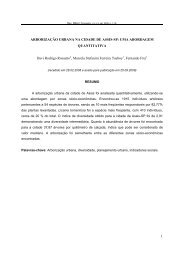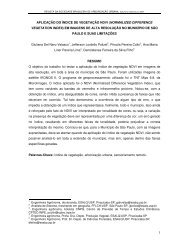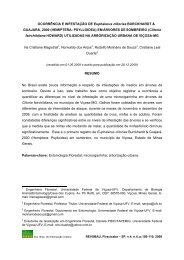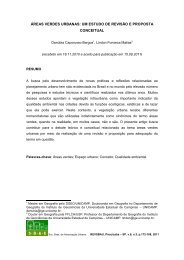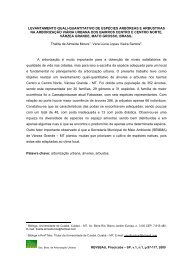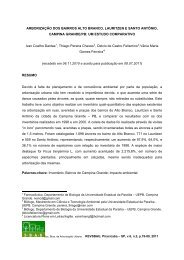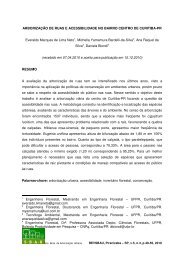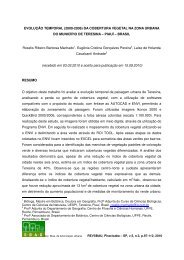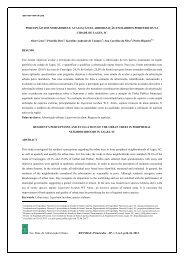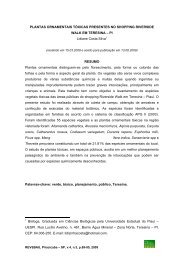compostos orgânicos voláteis biogênicos emitidos a partir de ...
compostos orgânicos voláteis biogênicos emitidos a partir de ...
compostos orgânicos voláteis biogênicos emitidos a partir de ...
Create successful ePaper yourself
Turn your PDF publications into a flip-book with our unique Google optimized e-Paper software.
26<br />
SCHIMER, W. N. & QUADROS, M.E.<br />
BIOGENIC VOLATILE ORGANIC COMPOUNDS FROM VEGETATION AND THEIR<br />
ROLE IN THE URBAN TROPOSPHERIC ZONE<br />
ABSTRACT<br />
Biogenic emissions of volatile organic compounds (BVOC's) emitted from natural sources<br />
(forested areas and ground vegetation) play an important role in the atmospheric chemistry,<br />
mainly in the lower atmosphere (troposphere). Sometimes, these compounds overcome the<br />
emissions from human activities and comprise isoprenes and terpenes, and other organic<br />
compounds in a lower mixing ratio (alcohols, esters, organic acids, etc.). Despite these<br />
compounds have an active participation in the atmospheric chemistry (acid rain, tropospheric<br />
ozone, influence in the air oxidative capacity), there is a small number of published works on<br />
these compounds in Portuguese language, even Brazil having the largest tropical forest of<br />
the world, what already would justify a huge research in this area. Such researches should<br />
comprise not only proper and specific samplings and analysis techniques, but a greater<br />
un<strong>de</strong>rstanding about the regional impacts of these gases related to current anthropogenic<br />
emissions.<br />
Key-words: Biogenic volatile organic compounds; forest; isoprene; terpenes; tropospheric<br />
ozone.<br />
INTRODUÇÃO<br />
Em se tratando <strong>de</strong> emissões gasosas <strong>de</strong> origem antropogênica, os <strong>compostos</strong><br />
orgânicos voláteis (COV) são uma importante classe <strong>de</strong> poluentes do ar, uma vez que<br />
incluem a maioria dos solventes e combustíveis em geral, sendo comumente <strong>emitidos</strong> tanto<br />
por fontes fixas (com <strong>de</strong>staque para as indústrias <strong>de</strong> processamento <strong>de</strong> petróleo) quanto por<br />
fontes móveis, como resultado da queima <strong>de</strong> combustíveis fósseis por veículos automotores.<br />
Assim, nesse caso, o principal problema está relacionado à emissão <strong>de</strong> solventes orgânicos.<br />
Solventes orgânicos são usados em um gran<strong>de</strong> número <strong>de</strong> aplicações industriais. Devido a<br />
sua volatilida<strong>de</strong>, em muitos <strong>de</strong>stes processos eles po<strong>de</strong>m ser <strong>emitidos</strong> diretamente [do<br />
processo <strong>de</strong> manufatura, nos tanques <strong>de</strong> estocagem ou ainda processos <strong>de</strong> tratamento<br />
(lagoas, etc.)] ou indiretamente na atmosfera, geralmente na forma <strong>de</strong> <strong>compostos</strong> orgânicos,<br />
após ter sofrido transformações físicas e/ou químicas. Estes solventes po<strong>de</strong>m ser divididos<br />
nas seguintes classes: (i) clorados, (ii) aromáticos, (iii) mono e poliálcoois, (iv) cetonas,<br />
alifáticos e outros (como ácidos orgânicos, indóis, etc.), sendo que os clorados e os<br />
Soc. Bras. <strong>de</strong> Arborização Urbana REVSBAU, Piracicaba – SP, v.5, n.25-42, p., 2010



